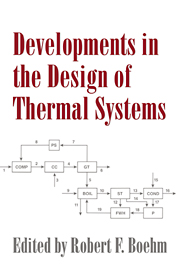Book contents
- Frontmatter
- Contents
- Preface
- Biographical sketches of the authors
- 1 Introduction and trends in the thermal design field
- 2 Computer-aided process design trends in the power industry
- 3 Automated design of chemical process plants
- 4 Thermophysical properties for design simulations
- 5 Introduction to Pinch Analysis
- 6 Second Law applications in thermal system design
- 7 Thermodynamic optimization of heat transfer and fluid flow processes
- 8 An introduction of thermoeconomics
- 9 Artificial intelligence in thermal systems design: concepts and applications
- Subject Index
- Author Index
8 - An introduction of thermoeconomics
Published online by Cambridge University Press: 23 September 2009
- Frontmatter
- Contents
- Preface
- Biographical sketches of the authors
- 1 Introduction and trends in the thermal design field
- 2 Computer-aided process design trends in the power industry
- 3 Automated design of chemical process plants
- 4 Thermophysical properties for design simulations
- 5 Introduction to Pinch Analysis
- 6 Second Law applications in thermal system design
- 7 Thermodynamic optimization of heat transfer and fluid flow processes
- 8 An introduction of thermoeconomics
- 9 Artificial intelligence in thermal systems design: concepts and applications
- Subject Index
- Author Index
Summary
Why thermoeconomics?
Nicholas Georgescu-Roegen (1971) pointed out in his seminal book, The Entropy Law and the Economic Process, that “… the science of thermodynamics began as a physics of economic value and, basically, can still be regarded as such. The Entropy Law itself emerges as the most economic in nature of all natural laws… the economic process and the Entropy Law is only an aspect of a more general fact, namely, that this law is the basis of the economy of life at all levels…”
Might the justification of thermoeconomics be said in better words?
Since Georgescu-Roegen wrote about the entropic nature of the economic process, no significant effort was made until the 1980s to advance and fertilize thermodynamics with ideas taken from economics. At that time most thermodynamicists were polishing theoretical thermodynamics or studying the thermodynamics of irreversible processes.
But the Second Law tells us more than about thermal engines and heat flows at different temperatures. One feels that the most basic questions about life, death, fate, being and nonbeing, and behavior are in some way related to Second Law. Nothing can be done without the irrevocable expenditure of natural resources, and the amount of natural resources needed to produce something is its thermodynamic cost. All the production processes are irreversible, and what we irreversibly do is destroy natural resources.
- Type
- Chapter
- Information
- Developments in the Design of Thermal Systems , pp. 203 - 233Publisher: Cambridge University PressPrint publication year: 1997
- 5
- Cited by



